2019 Honda Accord Vs. Mazda6 Sedan Comparison - VIDEO

It’s time for another comparison test! This go around, we’re looking at Honda’s venerable Accord and the suave Mazda6.
Get the Flash Player to see this player.
Each of these four-door family cars is upscale and well equipped, efficient to run and spacious inside. Really, you can’t go wrong with either example. Still, in this comparison we’re going to find out if one has any significant advantages over the other by performing a few tests, looking at things like real-world fuel economy, interior quietness, and even acceleration. But before getting to the meat of this comparison, here’s a little background information about these two models.
You could argue Honda’s 10th-generation Accord is the benchmark in this segment. Introduced for model-year 2018, it shocked the motoring world. Really, who knew a mid-sizer could be so good at so many things? Ensuring we got the full Accord experience, Honda sent us a top-tier Touring model for evaluation, one equipped with leather trimmings, a 10-speaker sound system, push-button start, heated rear seats, and much more.
The current-generation Mazda6 is a bit older than its rival but you’d never know it. Even though this sedan dates back to about 2012, it still looks like a million bucks, plus it was significantly refreshed in 2018, gaining an updated interior, a reinforced body structure, and retuned suspension among many other tweaks.
Keeping pace with the Accord, Mazda provided a top-shelf Signature model for testing. It came with loads of features and a cabin that’s more upscale than what’s found in some luxury cars.
A More-Than-Fair Fight
If it sounds like these cars are just about perfect rivals you’ve been paying attention. They’re so closely matched it’s almost like they’re copies of each other. Here’s the proof, in case any was needed.
Starting under the hood, both models feature turbocharged four-cylinder engines. The Honda’s displaces an even 2.0-liters and is rated at 252 horsepower with 273 pound-feet of peak torque. The Mazda has a half-liter displacement advantage and delivers an advertised 250 horses with 93-octane gasoline in the tank. Running regular grade gets you 227 ponies. With either fuel, torque production clocks in at 310 pound-feet, a nice advantage over the Accord. But parrying this blow, the Honda has four extra gears in its transmission, 10 versus just six in the Mazda.
SEE ALSO: 2019 Chevrolet Silverado 1500 vs. Ford F-150 Comparison – VIDEO
Surprisingly, fuel economy is a wash, at least according to the EPA. Mazda’s latest and greatest is rated at 23 miles per gallon around town (10.0 l/100 km), one better than the Honda (10.4 l/100 km). But the Accord has a one-mpg advantage on the highway cycle, topping out at 32 (Honda, 7.4 l/100 km; Mazda 7.5 l/100 km). Combined, they should both average 26 miles per gallon (Honda, 9.1 l/100 km; Mazda, 8.9 l/100 km).
Even more surprising than those similarities, when it comes to dimensions these cars are like twins. Their wheelbases and overall heights are identical, clocking in at 111.4 (2,830) and 57.1 inches (1,450 mm), respectively. Width and length are nearly the same as well. Each car is 192 inches and change (4,877 mm) long, about 73 inches (1,854) across.
Now, the Honda does have a slight advantage in weight and trunk volume. Tipping the scales at about 3,428 pounds (1,555 kg), it’s an advertised 152 pounds (69 kg) lighter than the Mazda. At 16.7 cubic feet (473 liters) in total, it also provides two additional cubic feet (57 liters) of storage space.
This underscores the fact that Honda is a master of space efficiency. The Japanese automaker’s vehicles often deliver far more interior volume than similar models from rival automakers. True to form, Accord leads in basically every cabin measurement, from overall passenger volume to rear-seat legroom, however, the Mazda6 is so close in nearly every interior dimension the differences are largely academic.
One area where these two cars diverge significantly is in parts content. If you want to wrap yourself in Ol’ Glory, grab the Honda. It’s built in Ohio, plus its engine and transmission are also made in the U.S-of-A. The Mazda is pretty much 100-percent Japanese.
But getting down to brass tacks, even the as-tested price of these two cars is basically identical. Including destination fees, which are both $920, the delta between them is a mere 55 bucks. The Mazda6 checked out at $36,815 ($41,000 CDN estimate), the Accord, $36,870 ($41,000 CDN estimate).
Real-World Testing
These cars are ridiculously comparable but helping discern if one has any real advantage over the other, we also performed plenty of objective testing. These examinations centered on cabin quietness, fuel economy, and acceleration.
Using a smartphone app to measure interior noise levels, we clocked the decibels both at idle and while cruising at 55 miles an hour on the same section of road. In both cases, this was done with all accessories turned off.
SEE ALSO: 2019 Lincoln Nautilus vs. Infiniti QX50 Comparison – VIDEO
Zero-to-60 acceleration was also measured. With both sedans in sport mode, we brake-torqued them and took off. Each car’s performance was averaged out over a series of three or four runs conducted on identical sections of road.
Finally, each sedan was taken on a roughly 100-mile-long fuel-economy loop consisting of urban, rural, and interstate driving. We topped off the tanks before heading out, putting premium fuel in the Mazda, per the manufacturer’s recommendation for maximum output. After the drive, we filled the cars up again to determine exactly how much fuel was burned.
Subjective Stuff
But before getting to the results of all that, let’s touch on a few subjective things. If this were a beauty contest it would be no contest. The Mazda6 is simply gorgeous from every angle, especially in this color. It’s called Soul Red Crystal and is a $595 upcharge ($450 CDN).
Sure, the Accord has a chiseled, square-jawed look, and it’s certainly a handsome car, but the overall design is, perhaps, a touch robotic. The Mazda is sensual, the Honda cerebral.
Inside, the Accord simply rocks. There’s plenty of richly grained plastic and all the controls are easy to figure out. This car has a nicer cabin than some Acuras, and that’s no joke! But what’s up with the shifter? No, it’s not hard to use, it’s just if you’re going to have an electronic gear selector, put it on the dashboard or steering column. Having it on the console wastes valuable space.
The Honda has a bit more backseat noggin-space and legroom than the Mazda, but the cushions are slightly less comfortable. As for the trunk, lift-over height is lower with the Accord at about 26.5 inches (673 mm) versus about 29 inches (737 mm), a minor advantage. The Honda’s infotainment system isn’t my favorite, but it’s speedy enough and gets the job done.
Thanks to its Nappa leather and stitched, Ultrasuede trim, the Mazda6 Signature’s cabin is pure luxury. And it feels a skosh richer than the Accord’s interior even if its fancy-sounding Japanese sen wood accents look and feel like run-of-the-mill plastic. There’s a Bose 11-speaker sound system and a heated steering wheel. Unfortunately, the infotainment system is a confounding mess and its touchscreen is disabled when the vehicle is in motion. I have coarse words for whoever thought that was a good idea. At least CarPlay and Android Auto are included. Also, the Mazda’s back-up camera is TERRIBLE, with all the resolution of a potato.
Both these sedans have a full complement of driver aids, things like blind-spot monitoring, lane-departure warning, automatic emergency braking, adaptive cruise control, traffic-sign recognition, and more. They’re also IIHS Top Safety Picks. Beyond that, each one has a head-up display and even ventilated front seats to keep your nether-regions cool.
Hammer-Time Honda
Behind the wheel, this Honda’s performance is astounding. It really feels like there’s Civic Type R DNA in this four-door family car. And that was reflected in its zero-to-60 performance.
Dropping the hammer, this Accord ripped to mile-a-minute velocity in a sports car-rivaling 5.7 seconds. It is SERIOUSLY FAST and makes nice sounds to boot. Undoubtedly, aiding that figure was the 10-speed gearbox. It’s nicely dialed in, tearing through its ratios with scarcely any harshness or slop.
As for the steering and ride quality, this thing is the real deal. It’s entirely pleasant to drive in nearly every respect, though the ride feels just a touch harsher than the Mazda’s.
One downside to the Accord is its brake pedal. The system is electrically rather than vacuum boosted and feels annoyingly robotic, like a video game or something. This can make stopping smoothly a challenge. I don’t like it at all.
As for interior quietness, this Honda registered about 64 decibels at idle and 87 while driving at 55 miles an hour.
After completing our fuel-economy loop, the Accord rolled a claimed 101.4 miles. Back at the filling station, we topped it up with 3.323 gallons of fuel, which resulted in 30.5 miles per gallon, much better than its EPA combined rating of 26. For reference, the trip computer said it averaged 30.4 mpg, a strong showing, in either case, especially considering it runs on regular-grade gasoline.
Mazda in Motion
Swapping into the Mazda6, I was a bit surprised. Sure, it’s a pleasure to drive, but it really didn’t feel any better or more engaging than the Accord. Either Honda is at the top of its game these days or I expected a little too much from Mazda.
This car’s driving position also didn’t fit me quite as well as the Honda’s. I found it a bit too high and the foot room slightly more restrictive. There’s also a plastic accent on the front seats that, annoyingly, kept poking me in the back.
The Mazda6’s engine delivers a veritable mountain of low-end twist, all without any torque steer, though it does feel just a tiny bit rougher than the Honda’s powerplant, and I mean a tiny bit. On the other hand, it’s also more immediate when you dip into the throttle, pulling vigorously, often without needing to downshift.
SEE ALSO: 2020 BMW 3 Series vs. Genesis G70 Comparison
But was the Mazda’s extra displacement enough overcome the Accord’s Type R soul and 10-speed gearbox? Squealing the tires at takeoff, it hit 60 miles an hour in an average of 7.4 seconds, a slower time than expected and one that’s about 1.7 ticks behind the pace set by Honda. Fortunately, that’s still plenty quick, plus it feels even faster than that figure indicates thanks to its fat torque curve.
With that “big-block” four-banger at tick-over, the Mazda6 emitted about 63 decibels of racket. At 55 miles an hour, that figure grew to a still-hushed 87. Surprisingly, it proved to be one-tenth of a decibel noisier on average than the Honda, a shocker since the Accord actually seemed significantly louder.
As for efficiency, the Mazda6 clocked 101.1 miles on our fuel-economy run, consuming 3.220 gallons of gasoline in the process. That equates to about 31.4 miles per gallon when worked out on paper. Again, that means this car handily beat its 26 mile-per-gallon combined rating. As for the onboard computer, it claimed a somewhat pessimistic 30.2 mpg.
The Verdict
From interior noise levels to real-world fuel economy, exterior dimensions to pricing, these cars are all over each other like chocolate-hazelnut spread on toast.
Recapping our findings in this comparison test, the Accord wowed us with its exceptional fuel economy, sports-car performance, refined transmission, and cavernous cabin. As for the Mazda, its sophisticated looks, luxury-car trimmings, torquey drivetrain, and real-world efficiency were equally impressive.
But not everything is perfect. The Honda’s bizarre brakes, seemingly noisy interior, and weird shifter put me off, plus everyone that doesn’t own a Camry probably drives one of these. The Mazda’s wood trim, infotainment system, blurry back-up camera, and ratio-shy transmission also proved to be letdowns.
At this point, I haven’t tested the 2020 Hyundai Sonata, but I’m comfortable calling these the two best midsize sedans available today. Each one is a fine choice, but for most drivers, the Honda is likely a mildly better option, however, if you’re more fashion-forward or want a car with a slightly nicer interior grab the Mazda6. They’re both excellent.
Discuss this comparison on our Honda Accord Forum or Mazda Forum!
The Specs
Honda Accord 2.0T Touring
Engine: 2.0-liter turbocharged four-cylinder
Output: 252 horsepower, 273 pound-feet of torque
Transmission: 10-speed automatic
U.S. Fuel Economy (MPG): 22 city, 32 highway, 26 combined
CAN Fuel Economy (L/100 km): 10.4 city, 7.4 highway, 9.1 combined
U.S. As-Tested Price: $36,870 including $920 for delivery
CAN Estimated Price: $41,000 including $1,655 for delivery
Mazda6 Signature
Engine: 2.5-liter turbocharged four-cylinder
Output: 227 horsepower (87 octane), 250 horsepower (93 octane), 310 pound-feet of torque
Transmission: Six-speed automatic
U.S. Fuel Economy (MPG): 23 city, 31 highway, 26 combined
CAN Fuel Economy (L/100 km): 10.0 city, 7.5 highway, 8.9 combined
U.S. As-Tested Price: $36,815 including $920 for delivery
CAN Estimated Price: $41,000
Honda Accord 2.0T Touring, Mazda6 Signature
LOVE IT
- Exceptional fuel economy
- Sports-car performance
- Refined transmission
- Cavernous cabin
- Torque-rich drivetrain
- Sophisticated styling
- Luxurious trimmings
- Efficiency
LEAVE IT
- Seemingly noisy interior
- Synthesized brake feel
- Weird shifter
- Popularity
- Confounding infotainment tech
- Terrible reversing camera
- Fake-looking wood trim
- Needs more gears

Born and raised in metro Detroit, Craig was steeped in mechanics from childhood. He feels as much at home with a wrench or welding gun in his hand as he does behind the wheel or in front of a camera. Putting his Bachelor's Degree in Journalism to good use, he's always pumping out videos, reviews, and features for AutoGuide.com. When the workday is over, he can be found out driving his fully restored 1936 Ford V8 sedan. Craig has covered the automotive industry full time for more than 10 years and is a member of the Automotive Press Association (APA) and Midwest Automotive Media Association (MAMA).
More by Craig Cole




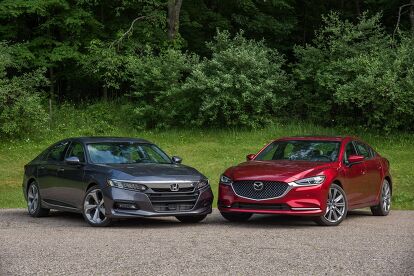



































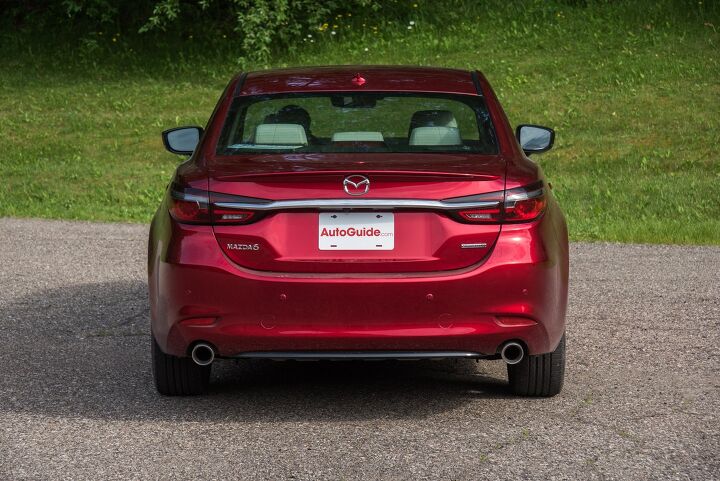



























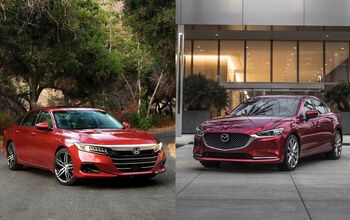


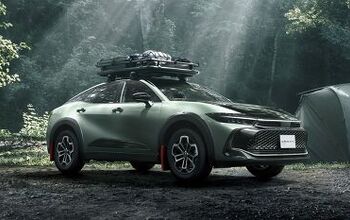




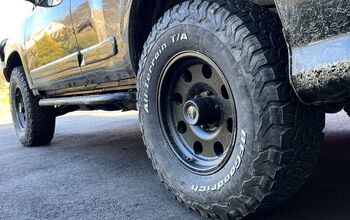
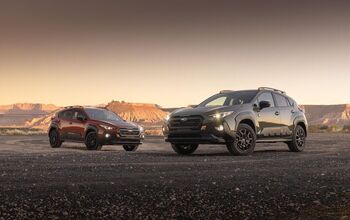
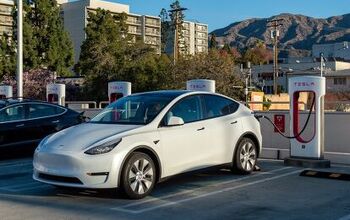
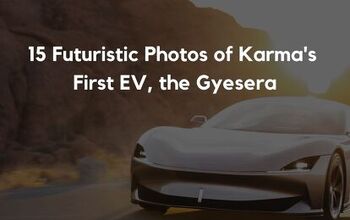

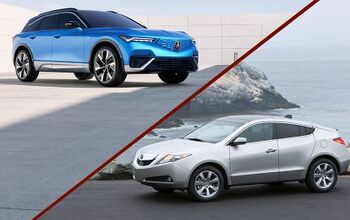
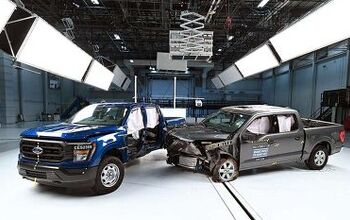
Comments
Join the conversation